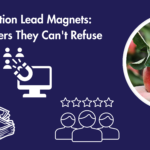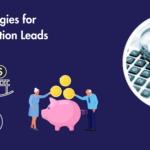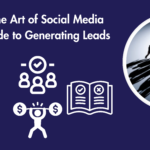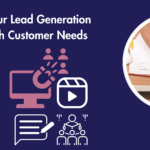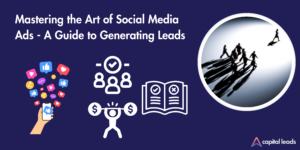Lead generation is absolutely vital in the competitive realm of business lending.The ability to attract quality leads can truly set your business apart.
But it’s more than just a numbers game; effective lead generation lays the foundation for enduring relationships that are mutually beneficial. Fostering long-term loyalty and trust between you and your clients.
In this comprehensive guide, we’re going to dive into a variety of strategies and practical tips that will elevate your ability to find and retain potential clients.
Whether you’re new to the business lending sector or looking to refine your existing strategies, this guide is tailored to help you navigate the complexities of lead generation with ease.
Understanding Your Audience
Getting to know your audience is like putting together a puzzle in the business lending world. It’s all about figuring out who they are, what they need, and how they decide on things.
This step is super important because it helps you talk to them in a way that really clicks.
Your audience might be anyone from a business pro to someone just stepping into the world of loans. They all have different needs, like understanding loan terms or figuring out how to qualify. When your content speaks directly to these needs, it becomes something they want to read and use.
To really get under the skin of your audience, good market research is key. It’s not just about reading reports. It’s about getting out there and asking questions. Think about doing surveys, having chats, or even setting up group discussions to hear straight from the horse’s mouth.
With this knowledge in your toolkit, you can make your content strategy even better. It could mean writing detailed guides for newbies in the business loan world or giving more advanced tips for the seasoned borrowers.
The main thing is to make your content a go-to resource that not only answers their questions now but also helps them down the road.
Content That Solves Problems

When it comes to creating content, it’s all about hitting the nail on the head for what your potential borrowers are struggling with. It’s like being the helpful friend who has the answers they need.
You want to focus on making content that zeroes in on their specific problems or questions. This kind of approach makes your content super relevant and useful, which is exactly what you want.
Let’s talk about the kinds of content that are great for solving problems. First up, how-to guides are a winner. These can be step-by-step articles or videos that walk people through processes like applying for a business loan or understanding different types of lending options.
Then there are case studies, which are real-life stories about how other businesses tackled similar issues. These are great because they show your audience that solutions are possible and they’re not alone in their struggles.
And don’t forget about FAQs – these are perfect for answering those burning questions that pop up again and again.
Let’s break down the types of content that are great for solving problems:
How-to Guides
These are step-by-step articles or videos that guide people through processes like applying for a business loan or understanding different types of lending options. They’re practical, easy to follow, and incredibly valuable for those new to business financing.
Case Studies
Real-life stories about how other businesses tackled similar financial challenges. Case studies show practical examples and solutions, making them relatable and inspiring. They demonstrate that the struggles are common and solvable, providing a sense of camaraderie and hope.
FAQs
Frequently Asked Questions are perfect for addressing those common queries that many borrowers have. They are direct, to the point, and often cover a wide range of topics, making them a go-to resource for quick information.
By focusing on these types of content, you’re essentially giving your potential borrowers a toolbox of solutions. This not only helps them in the immediate sense but also builds trust.
They’ll start seeing you as a reliable source that understands their needs and has the know-how to help them out. That’s the kind of relationship that turns a potential borrower into a loyal client.
Here are examples for each type of content tailored for a lender or lending business:
How-to Guide
Title: “How to Choose the Right Business Loan for Your Startup”
Summary: This guide walks potential borrowers through the process of selecting the most suitable business loan. It covers understanding different loan types, evaluating interest rates, and considering repayment terms. The guide also includes tips on preparing a compelling loan application and explains common jargon in simple terms.
Case Study
Title: “Transforming Dreams into Reality: How ‘XYZ’ Secured Their First Business Loan”
Summary: This case study narrates the journey of ‘XYZ’ a small startup that navigated the business loan process successfully. It highlights the challenges they faced, such as limited credit history and understanding loan options.
The study focuses on the strategies they used, the interaction with the lender, and how the loan impacted their business growth, offering real-life insights and encouragement to other potential borrowers.
FAQs
Title: “Your Top Questions About Business Loans Answered”
Sample Questions:
Q: What factors do lenders consider when approving a business loan?
A: Lenders typically look at your business credit score, revenue, time in business, and the purpose of the loan, among other factors.
Q: How can I improve my chances of getting a business loan?
A: Maintain a strong credit score, prepare detailed financial statements, have a solid business plan, and understand your borrowing needs.
These examples are designed to provide practical, relatable, and valuable content for potential borrowers in the lending space, helping them navigate the complexities of securing a business loan.
The Power of Storytelling
Storytelling is a potent tool in the arsenal of content creation, especially in the lending industry. A well-told story can bring a concept to life, making it more engaging and relatable for your audience.
In the context of business lending, stories can transform abstract financial concepts into tangible experiences that potential borrowers can connect with emotionally.
Why Storytelling Works:
Creates a Connection
Stories humanise your brand, allowing borrowers to see themselves in the narrative.
Simplifies Complex Ideas
A narrative can make complicated financial topics more digestible and understandable.
Evokes Emotion
Emotional engagement can be a powerful motivator for action.
Tips on Crafting Effective Stories
Identify With Your Audience
Know the challenges and aspirations of your borrowers. Craft stories that reflect their experiences and goals.
Be Authentic
Authenticity in storytelling builds trust. Share real stories of past clients (with their permission) or create realistic scenarios.
Incorporate Key Messages
Weave your services and benefits naturally into the story. Show, don’t just tell, how your lending solutions can help.
Use Vivid Descriptions
Paint a clear picture with your words. Use descriptive language to make the story more vivid and memorable.
Include a Clear Call-to-Action
Every story should lead the reader towards an action, whether it’s to learn more, contact you, or apply for a loan.
By integrating storytelling into your content strategy, you not only captivate your audience but also effectively communicate how your lending services can play a pivotal role in their success stories.
SEO Strategies for Visibility
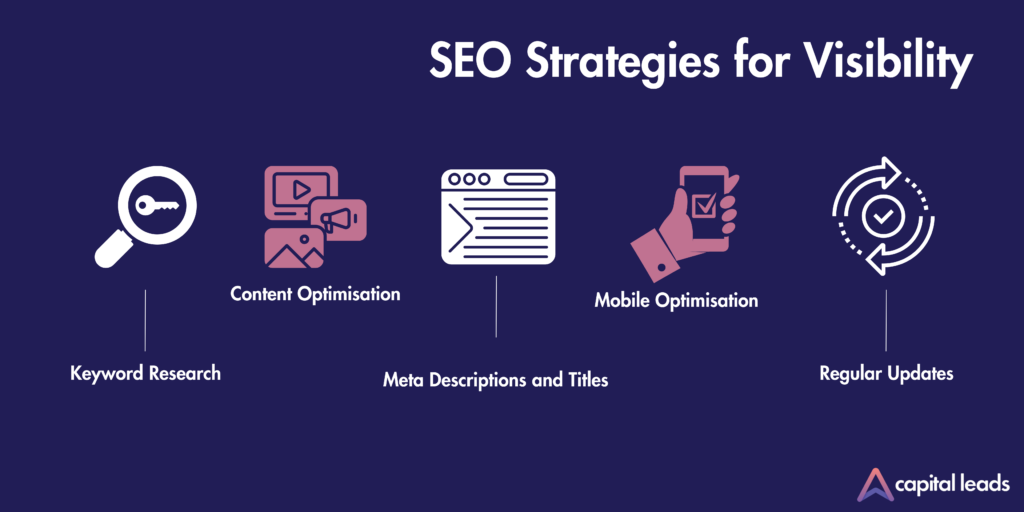
When it comes to digital content, creating it is only half the battle. The other half is making sure it gets seen by the right audience, and that’s where SEO (Search Engine Optimization) comes into play. SEO is the key to ensuring your content pops up when potential borrowers are searching online for information related to business loans.
Importance of SEO
Targets Relevant Audience
Good SEO practices help your content reach people actively seeking information about business lending.
Increases Online Visibility
Well-optimised content ranks higher in search results, making it more likely to be seen and clicked on.
Best Practices for SEO
Keyword Research
Start by identifying keywords that your target audience uses when searching for business lending information. Tools like Google Keyword Planner or SEMrush can help you find relevant keywords.
Content Optimisation
Use these keywords naturally in your content, including in titles, headers, and the body text. Remember not to overstuff keywords; keep it readable and natural.
Meta Descriptions and Titles
Craft compelling meta titles and descriptions with keywords. This can improve click-through rates from search results.
Mobile Optimisation
Ensure your content is mobile-friendly, as a significant portion of searches are done on mobile devices.
Regular Updates
Keep your content updated with the latest information to maintain its relevance and ranking.
Leveraging Different Content Formats
Different people prefer different types of content. By diversifying the formats of your content, you can engage a wider audience and cater to various preferences, enhancing both engagement and lead generation.
Exploring Content Formats
Blog Posts
Ideal for in-depth explanations and guides. Ensure they are well-structured with headers, bullet points, and images for easy readability.
Videos
Great for tutorials or storytelling. They can be more engaging than text and are especially effective on social media platforms.
Infographics
Perfect for presenting data or processes in a visually appealing and easily digestible format. Infographics are highly shareable on social media.
Webinars
Useful for in-depth discussions or presentations. They also offer an opportunity for live interaction with your audience.
Interactive Tools
Such as loan calculators or quizzes, can be engaging ways to provide value to your audience while collecting lead information.
By utilising these diverse content formats and following best practices, you can effectively engage different segments of your audience, catering to their unique preferences and enhancing your lead generation efforts.
Crafting a Strong Call-to-Action
A call-to-action (CTA) is like the finishing touch on your content; it’s what turns readers into doers. In the lending industry, where decisions can significantly impact someone’s business, a clear and compelling CTA isn’t just nice to have; it’s essential.
It guides your potential borrowers on what to do next, whether that’s applying for a loan, getting in touch for more info, or downloading a guide.
Importance of a Strong CTA
Drives Engagement
A well-crafted CTA encourages your audience to engage further with your brand, moving them down the conversion funnel.
Increases Conversion Rates
A compelling CTA can transform passive readers into active leads and customers.
Tips for Crafting Effective CTAs
Be Clear and Direct
Your CTA should leave no doubt about what you want the reader to do next. Phrases like
“Apply Now”, “Get Started Today”, or “Contact Us for a Free Consultation” are direct and unambiguous.
Create a Sense of Urgency
Use language that encourages immediate action, like “Apply now and get started”, or “Limited time offer”.
Stand Out Visually
Make sure your CTA button or link is visually distinct from the rest of the content. Use colors that contrast yet complement your overall design.
Placement Matters
Ideally, place your CTA where it’s most likely to be seen without disrupting the content flow, such as at the end of an article or in a sidebar.
Examples of Effective CTAs in Lending
“Ready to Boost Your Business? Apply for Your Loan Today!”
“Don’t Miss Out – Grab Your Free Guide to Business Financing Now!”
“Start Your Journey to Financial Freedom – Contact Our Loan Experts!”
Measuring Content Effectiveness
Knowing if your content hits the mark is crucial. That’s where measuring content effectiveness comes in. It’s about using the right tools and methods to track how your content performs, and then using those insights to make your content strategy even better.
Methods and Tools for Tracking Performance
Analytics Tools
Use tools like Google Analytics to track website traffic, page views, time spent on page, and bounce rates. These metrics give you a clear idea of how engaging your content is.
Social Media Metrics
Platforms like Facebook and LinkedIn provide insights into how your content is performing in terms of shares, likes, comments, and reach.
Lead Tracking
Monitor how many leads are generated from specific pieces of content. Tools like HubSpot or Salesforce can help track these conversions.
Using Insights to Refine Strategy
Identify What Works
Look for patterns in your data. Which types of content get the most engagement or leads?
Use this information to focus your efforts on what’s most effective.
Understand Your Audience Better
Use analytics to get a deeper understanding of your audience. What are they interested in? When do they engage with your content the most?
Test and Tweak
Don’t be afraid to experiment. Use A/B testing for different elements of your content to see what resonates best with your audience.
By consistently measuring the effectiveness of your content and applying the insights you gain, you can continually refine your approach, ensuring your content not only resonates with your audience but also drives your lead generation efforts forward.
Conclusion
Mastering content creation and optimisation in the lending industry is a blend of art and science. From crafting compelling stories to implementing robust SEO strategies and understanding the effectiveness of your content, each step is a building block towards attracting and converting high-quality leads.
At Capital Leads we offer high-quality, 100% exclusive leads that your sales team will love – straightforward, consistent, and reliable. With over a decade deep in the digital realm and more than 20 years of sales experience, we’re not just another lead generation company. We’re experts who bridge the gap from nurture to sale.
Visit Capital Leads to learn more about leads for your business. Ready to jump straight into the high quality leads? Get started now.

